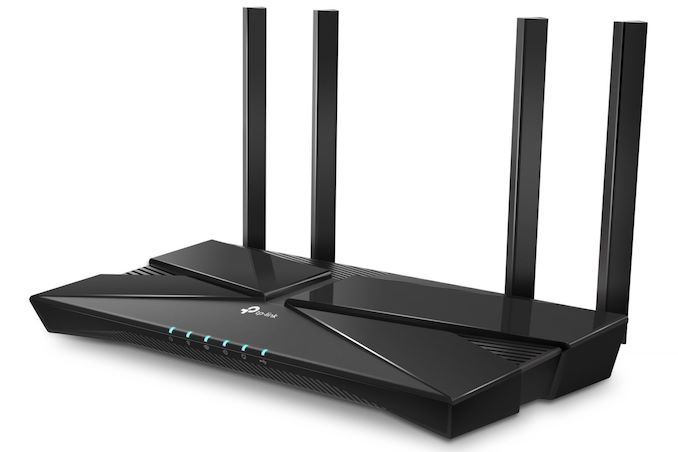AT 101: Wi-Fi 6 And Why You Want It
by Brett Howse on February 12, 2020 8:00 AM EST
Over the last generation of computing, there has been an explosion of devices that no longer have or need the capability of connecting to a hard-wired Ethernet connection, and that trend shows no intention of slowing down. When Personal Computers first started to utilize wireless Network Interface Cards (NICs) they would almost always be the sole device on the network. Fast forward to today, and practically every home has multiple devices, if not dozens, where the devices communicate using radio waves, either over a cellular connection, or over a home wireless network featuring Wi-Fi.
In the PC space, which is the focus of this article, cellular connectivity certainly exists, but almost exclusively in niche roles. While there are advantages to offering directly cellular connection on the PC, the extra recurring cost, especially in North America, means that most laptop owners will use Wi-Fi for network communication.
The term Wi-Fi is something that is omnipresent today, but if based on the Wi-Fi Alliance and adoption of IEEE 802.11 standards for local area networking over wireless. Although the Wi-Fi Alliance has recently renamed their standards, Wi-Fi has in the past been named directly based on the 802.11 standards as follows:
| Wi-Fi Names and Performance | ||||||
| Naming | Peak Performance | |||||
| Branding | IEEE Standard |
1x1 Configuration |
2x2 Configuration |
3x3 Configuration |
||
| Wi-Fi 4 Channel Width 20/40 MHz |
802.11n | 150 Mbps | 300 Mbps | 450 Mbps | ||
| Wi-Fi 5 Channel Width 20/40/80 MHz Optional 160 MHz |
802.11ac | 433 Mbps 867 Mbps |
867 Mbps 1.69 Gbps |
1.27 Gbps 2.54 Gbps |
||
| Wi-Fi 6 Channel Width 20/40/80/160 MHz |
802.11ax | 1201 Mbps | 2.4Gbps | 3.6 Gbps | ||
In an effort to simplify branding, the latest three standards of 802.11n, 802.11ac, and 802.11ax have been rebranded to Wi-Fi 4, Wi-Fi 5, and Wi-Fi 6, respectively. In the long term, the new branding should be much easier for most people to grasp, since larger means newer, although we’ve already got some confusion with Wi-Fi 6E – the 6GHz band addition for Wi-Fi 6 – so we shall see how that goes.
 One of the many Wi-Fi 6 routers announced at CES 2019 - TPLink AX1800
One of the many Wi-Fi 6 routers announced at CES 2019 - TPLink AX1800
Today, most homes should have at least Wi-Fi 4, or what used to be 802.11n. After all, this standard came along in 2009. Many will even have Wi-Fi 5, or 802.11ac, which offers some speed upgrades and a few optional extra features to help with scaling. Wi-Fi 6, or 802.11ax, is a very new standard, and until the end of 2019 there were not even that many devices which could connect over it. So, what is the point of this new standard, and do you really need to upgrade your home network?
This article intends to help answer those questions, as well as show how we at AnandTech are transitioning to Wi-Fi 6 for future reviews.











149 Comments
View All Comments
Gonemad - Friday, February 14, 2020 - link
Nah. I just decided to get my home cabled. When the wireless get faster than the cables, I will consider it.Very few devices stuck with wifi 4 or 3, for example my aging PS3. I got it cabled. Great blu-ray and netflix player.
Gonemad - Friday, February 14, 2020 - link
Cabling my home was more cost-effective for aging gear. New gear will demand a new router, eventually.Gigaplex - Monday, February 17, 2020 - link
Looking at the table that defines the max speeds of the various versions, I'm a bit disappointed that my 2x2 AC wifi can only get ~100Mbit 2 metres away with direct line of sight. It's only off by an order of magnitude...zepi - Monday, February 17, 2020 - link
What is your test device actually? You talk of ”typical laptop 2x2” etc. But please write out what exactly.I already have 3x3 AP + laptop for AC with 80MHz. Actually many people do.
azazel1024 - Wednesday, February 19, 2020 - link
That isn't disappointing for 2.4GHz performance, that sounds like something is wrong, like it is fat channel intolerant enabled or something similar. I'd trouble shoot more or talk to Intel on what's wrong.By comparison older 802.11ac Intel network cards (7260, 7265) on 2.4GHz 40Mhz 2:2 I can generally get around 200-215Mbps. Which is well over double the performance that you are seeing with the AX200 Intel card. That to me says either something is dropping it down to 20Mhz (which still isn't a strong showing, even for 20Mhz), or else there is some kind of bug in the firmware. I'd expect better than 802.11ac/802.11n performance in the 2.4Ghz space. Like around 240-280Mbps because of the higher QAM encoding.
Schumway7 - Saturday, February 22, 2020 - link
Can I upgrade my current wi-fi with new WIFI 6 or need a new service,with a new bill?FXi - Wednesday, February 26, 2020 - link
At this point in time I think most will be well served to wait for Wifi 6e. Clients should be coming along right now and the added channels that "e" will make available really give Wifi 6 the room to deliver on the speed increases.0ldman79 - Tuesday, March 10, 2020 - link
Isn't -21dB overdriving the receiver?I find typically anything stronger than a -40 has worse performance.
Also another client radio may give better results. I've found Intel to be quite problematic in the past. Qualcomm Atheros, Realtek or Broadcom have generally performed better than Intel, though you have to test with what is available.
pirspamela90 - Tuesday, December 15, 2020 - link
Very original and specific model but thank you for your review.